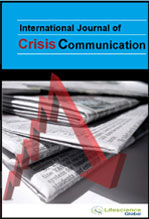IJCJ
Abstract : Insights on the Influence of the Attributes of the Arab Culture on Crisis Communications
|
|
Abstract: An organization’s image and reputation are assets that are built up over time. Organizations seek to develop and maintain positive images in the minds of publics. The image of an organization can be threatened by crises, and this impacts the trust it has with its employees and customers. Trust declines when employees feel they are not informed properly, especially in times of crises when it is imperative to respond to the threat and where promptness is necessary. Communications help build or restore some level of trust. The case is also applicable on a social level where governments and the public should communicate effectively especially during crises. Two main issues will be discussed in this paper: First, the influence of culture on the practice of Crisis Communications (CC); and second, the factors that underpin the role of culture in CC. These issues are significant since they represent the characteristics and influence of the Arab culture in particular. This article contributes to the understanding of the significance of culture in CC for organizations operating in the Arab World. Keywords: Culture, reputation, standardization, crisis communications, organizations, crisis messages, Arab World. |
Abstract : Applying Social Media in Crisis Communication: A Quantitative Review of Social Media-Related Crisis Communication Research from 2009 to 2017
|
|
Abstract: Social media has drawn growing attention from crisis communication researchers. The purpose of this study was to provide an overview of the current paradigm of research on social media and crisis communication, to identify the research gaps, and to help scholars understand future research directions in this area. The current study examined the trends and patterns of social media-related crisis communication research published in 11 communication and public relations journals from 2009 to 2017. More specifically, it focused on the trends and characteristics of research topics, theories and theoretical models, crisis types, social media platforms, sample types, and research methods. This study found that public relations-focused journals published most of the social media-related crisis communication articles. Most studies adopted theories or theoretical models and examined the role of social media in crisis communication, which focused on product tampering and general crisis. Additionally, a considerable number of studies employed content analysis techniques that used social media content as the sample. This study discussed the trends of social media-related crisis communication research and the directions for future research. Keywords: Crisis communication, social media, research trend, public relations, communication. |
Abstract : How Crisis Journalists Can Magnify The Voices of Poor, Marginalized Communities of Color (2)
|
|
Abstract: In light of the historical animus that exists between poor, marginalized communities of color and members of law enforcement, this manuscript will focus on the role of crisis journalists in helping bridge this divide. Research abounds regarding the many physical, psychological, financial, legal, and social inequities between poor, marginalized communities of color, and as such, members of this group have come to accept that: (1) no one wants to hear about their experiences; (2) no one cares about their experiences; or (3) no change will come from voicing their experiences. Given these realities, I will provide specific ways that crisis journalists can encourage members of this group to share their experiences, why it would be advantageous for crisis journalists to offer their findings to law enforcement and members of the judiciary to provide a deeper (gives a contextual understanding of the lives of poor, marginalized communities of color). Furthermore, I discuss how crisis journalists can work with other professionals (researchers, practitioners) to create a Community of Care. Keywords: Community of Care, Crisis Journalists, Law Enforcement, Poor Communities, Practitioners, Qualitative, Researchers, Social Inequity. |
Abstract : Analysis of Pakistan Print Media Narrative on the War on Terror
|
|
Abstract: This study examines the coverage of the Taliban conflict in four leading national newspapers of Pakistan from January 2014 to July 2014 from war and peace journalism perspective. The theoretical framework for this research is determined by peace journalism and framing theories, while the sample was selected by applying the systematic random sampling method. The findings, based on a content analysis of 821 stories from the four newspapers, indicate that the Pakistani media are inclined more towards war journalism framing than peace journalism framing in their coverage of the Taliban conflict. The two Urdu dailies namely Nawa-i-Waqt and Express have a stronger preference for war than peace compared to the two English dailies namely Dawn and The News International. Consistent with the existing peace journalism scholarship, the findings of this study also show that the newspapers not only toed and supported the official version on this home-grown conflict but also marginalized and undermined alternative voices calling for a peaceful resolution of this years-long conflict. Keywords: War on terror, conflict coverage, peace journalism, national security, propaganda. |























